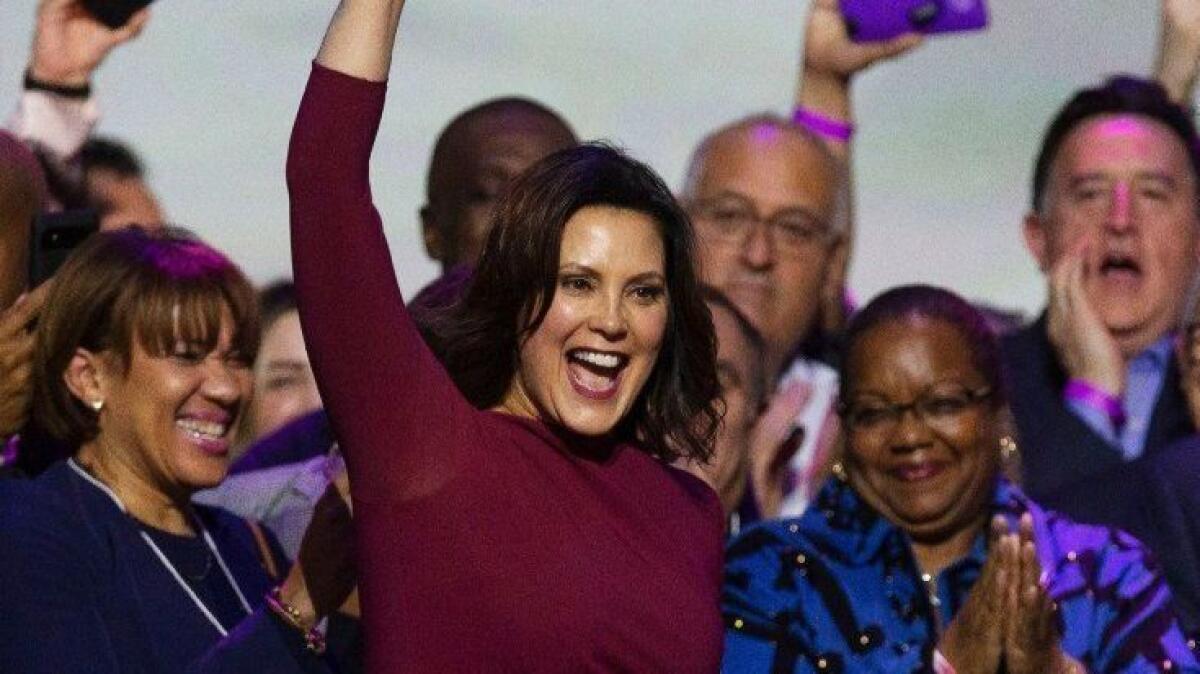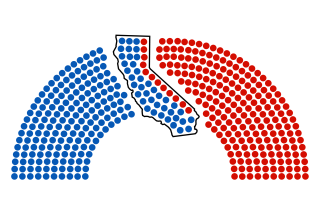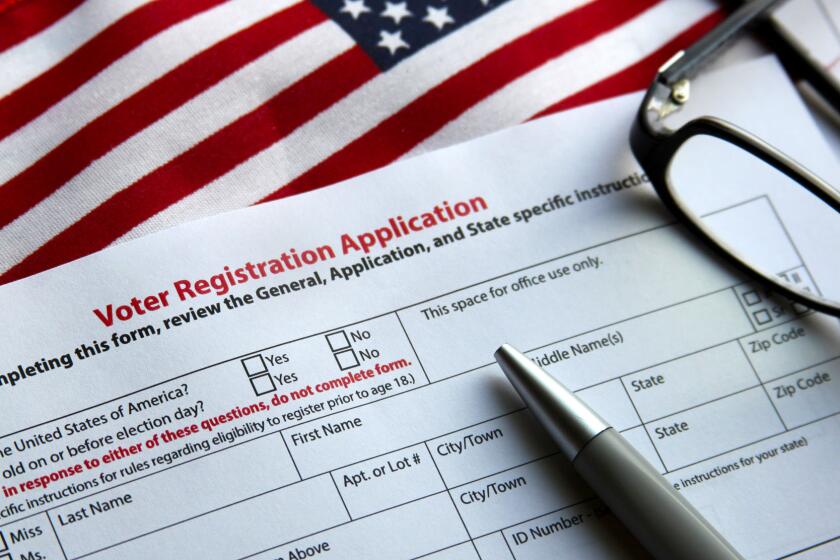Democrats capture several governors’ mansions from Republicans

Democrats captured governors’ offices in states across the country that Republicans have controlled since at least the early years of the Obama presidency, eroding the GOP’s dominance in state capitals.
In Kansas, one the most conservative states in the nation, Democratic state Sen. Laura Kelly defeated Kris Kobach, the polarizing secretary of state who helped lead President Trump’s failed commission on voter fraud. That panel disbanded after being unable to produce evidence supporting both men’s claims of rampant fraud.
Kobach fell short after running hard to the right. He found himself up against electoral head winds created by fallout from deeply unpopular tax cuts championed by former Gov. Sam Brownback, another Republican, which starved state government and forced deep cuts in core services.
Although the blue wave that Democrats had hoped for may not have materialized, their party’s considerable inroads in state capitals, as well as its capture of a majority in the U.S. House, made for a celebratory night nonetheless. The results stood, with exceptions in some red states and Florida, as a rebuke to Trump.
Democrats also won the governor races in Republican-ruled Illinois, Michigan and New Mexico, and were expected to win in Maine. In Illinois, first-term Gov. Bruce Rauner was unseated by billionaire Democrat J.B. Pritzker, while in Michigan, Republican Gov. Rick Snyder was unable to seek reelection because of two-term limits. But Republicans retained control in Ohio, where Mike DeWine withstood a strong Democratic challenge from Richard Cordray for the nod to succeed retiring Republican Gov. John Kasich.
Democrats had hoped to finally break the unusual dominance over state governments that the Republican Party has enjoyed for much of the decade. Republicans have used their power in the states as a launchpad for conservative policies, empowering them to undermine President Obama’s Affordable Care Act, his actions against climate change, organized labor and reproductive rights nationwide.
Their hold on two-thirds of the nation’s governorships and many legislatures also enabled Republicans to draw voting boundaries for federal and local offices that solidified their lock on power in the states and Congress.
Just 16 governors currently are Democrats while more than twice as many — 33 — are Republicans; one is an independent. Democrats went into the election hoping to claim as many as 10 of the governorships held by Republicans and also to flip a dozen legislative chambers. They will probably fall short of that goal once final voting returns are in, but the gains they achieved Tuesday are nonetheless substantial.
Beyond the ideological shift in policymaking, the victories allow Democrats to take back some control of the redistricting pens when new political boundaries are drawn after the 2020 census.
But in some key states Republicans were still holding on.
Republicans eked out a win in the high-stakes race for governor in Florida, keeping control there. Democrats had been optimistic for Andrew Gillum, the mayor of Tallahassee and an unapologetic progressive, who ran on an agenda that includes Medicare for all, robust gun safety laws and higher corporate taxes. Gillum would have been Florida’s first African American governor.
Few races nationwide were as much a referendum on Trump. Gillum was the only gubernatorial candidate demanding the president’s impeachment. His victorious Republican rival, Rep. Ron DeSantis, is a strident Trump loyalist, who built his campaign around his allegiance to the president and his policies.
Trump inserted himself into the race often, attacking Gillum as an under-qualified and corrupt socialist. Although Democrats’ path to statewide office had long been through the political center, progressives had hoped a victory for Gillum would give them a boost as they build their case that the party’s best hope in 2020 for retaking the White House is in nominating a progressive candidate. It didn’t happen.
Democrats were also facing disappointment in neighboring Georgia, where their gubernatorial nominee, Stacey Abrams, also had hoped to make history by becoming the state’s first African American governor — and the first black woman governor in the nation. Abrams was trailing in a tight race against Secretary of State Brian Kemp, another close Trump ally, whose management of the state’s voter files sparked a national outcry.
Kemp purged tens of thousands of voters from the registration rolls, calling it necessary to prevent voter fraud. But most of the voters purged are African Americans, prompting Democrats and civil rights activists to charge that Kemp’s actions recalled the long history of voter suppression in the South.
Elsewhere in the country, though, Republicans running to keep their party in the governors’ mansions were falling short in early returns.
In Maine, Democrats were poised to capture the governor’s office now that term limits are ending the eight-year occupancy of a racially inflammatory, shoot-from-the-hip conservative, Gov. Paul LePage. The Democrats’ nominee, state Atty. Gen. Janet Mills, had enjoyed a commanding lead in polls throughout the race over Republican Shawn Moody.
It may be in the Midwest where the political landscape is likely to be most altered. Almost every governor’s office in the region is currently controlled by a Republican, and Democrats were within reach of flipping a number of them.
That includes in Wisconsin, where Gov. Scott Walker built a national following and, before 2016, a lot of buzz about his presidential prospects — by fighting Obamacare, going to war with organized labor and aggressively cutting back government services. Walker’s bid for a third term was threatened by a strong challenge from Democrat Tony Evers, the state superintendent for public instruction. Late Tuesday, the race was too close to call with two-thirds of the votes counted.
Voter fatigue with Republican policies was evident throughout the region and into the heartland during this campaign.
Illinois’ Rauner, a blustery Republican, was ousted after a tenure marked by a budget deadlock in Springfield and a deadly outbreak of Legionnaires’ disease at a home for veterans, which triggered a criminal investigation into his administration.
In Michigan, the Republican nominee, Atty. Gen. Bill Schuette, was politically damaged by his unyielding opposition to the state’s popular Medicaid expansion and resistance to raising revenue to fix the state’s abysmal roads. He was defeated by Democrat Gretchen Whitmer, a former state legislator who has never held statewide office.
Democrats also flipped the governor’s office in New Mexico, where Rep. Michelle Lujan Grisham, a strident foe of Trump on immigration and environmental issues, beat Rep. Steve Pearce, a member of the militantly conservative House Freedom Caucus. The current governor, Republican Susana Martinez, was term-limited.
The battleground prize of Ohio had seemed to teeter for Republicans up until election night. Trump visited on Monday to stir up conservative voters there, branding Democrat Cordray, the first chief of the federal Consumer Financial Protection Bureau, as an apprentice of liberal Sen. Elizabeth Warren.
But Trump, who spent much time on the Cleveland rally stage mocking Warren’s claim to Native American ancestry and calling her “Pocahontas,” may have motivated enough conservatives to push DeWine, the state attorney general and a former congressman and U.S. senator, over the top.
Of the several statehouse chambers up for grabs, Democrats were well positioned to capture many of them. For example, in Wisconsin and Maine, with their strong Democratic gubernatorial candidates atop the ballots, the party had the potential to also regain control of the state senates.
In Colorado, the outcome of a costly fight over control of the state Senate could restore Democrats to full control of the state government there. And in New York, the collapse of a power-sharing agreement that enabled minority Republicans to control the state Senate also put Democrats in position to control state government there.
In other states, from Florida to Michigan to Arizona, analysts projected that Democratic voters’ enthusiasm for top-of-the-ticket candidates could trickle down to those lower on the ballot, allowing Democrats to at least shrink Republicans’ commanding majorities in several chambers.
Tim Storey, an elections analyst at the National Conference of State Legislatures, said that, going into the election, “Republican are as strong as they have been in American history. They control more legislatures than they ever had.”
But, Storey added, eventually the laws of physics were bound to catch up with them: “What comes up must go down.”
The latest look at the Trump administration and the rest of Washington »
More stories from Evan Halper »
evan.halper@latimes.com | Twitter: @evanhalper
More to Read
Get the L.A. Times Politics newsletter
Deeply reported insights into legislation, politics and policy from Sacramento, Washington and beyond. In your inbox three times per week.
You may occasionally receive promotional content from the Los Angeles Times.











